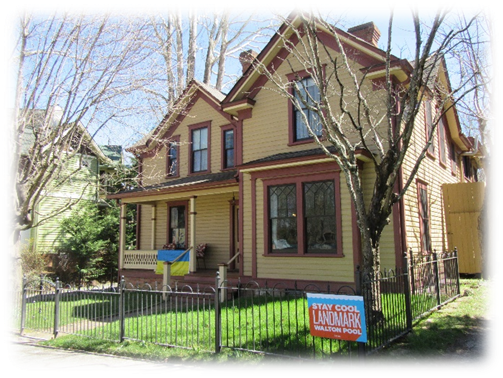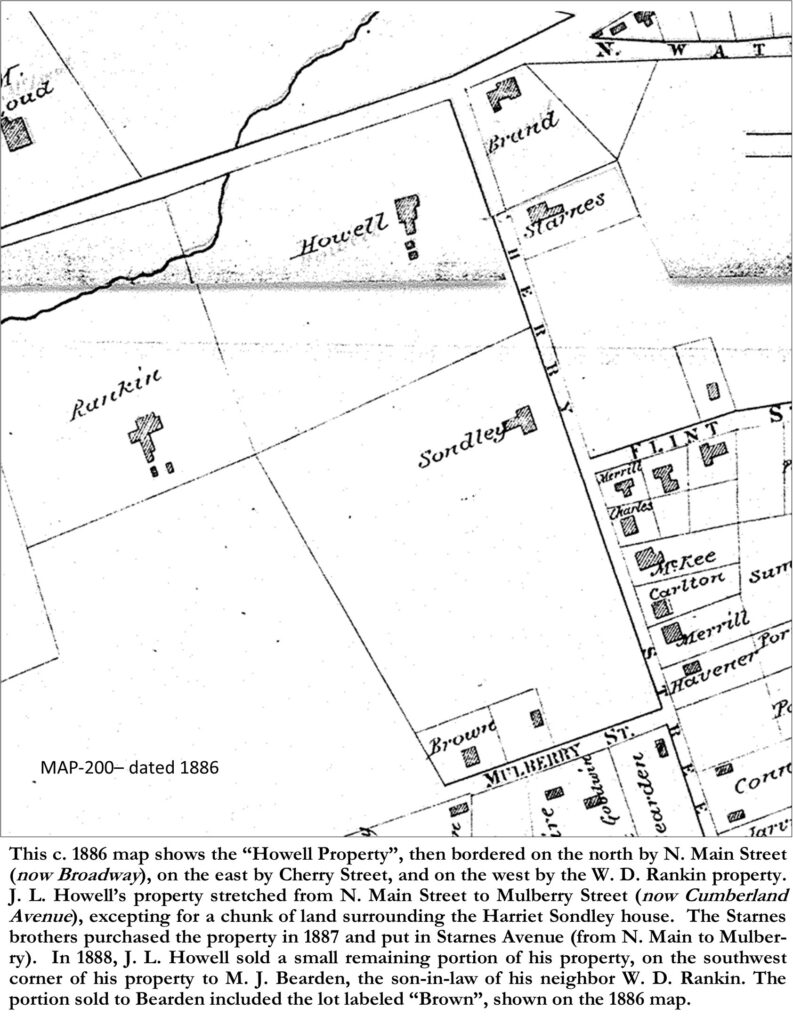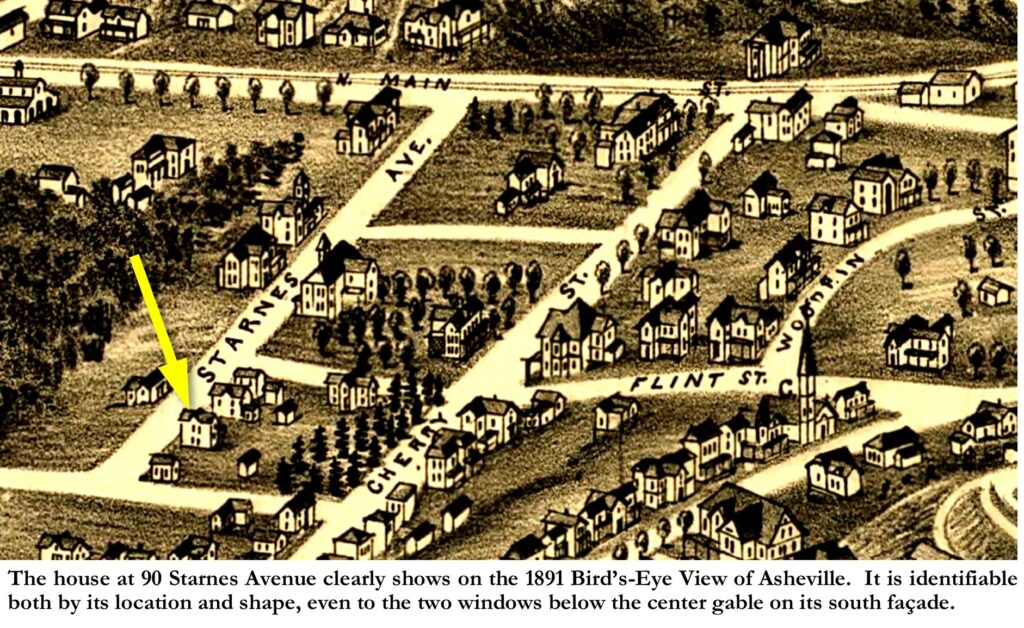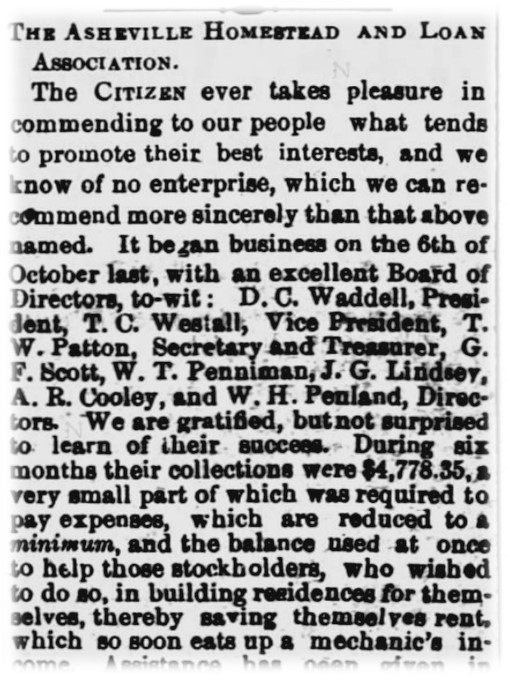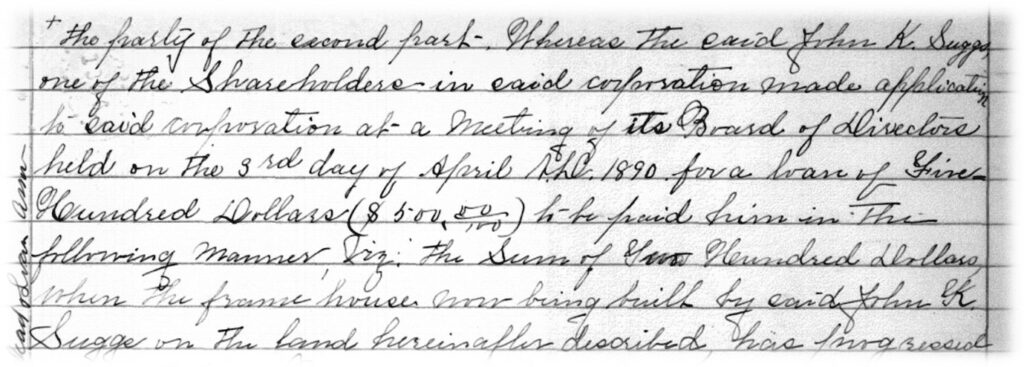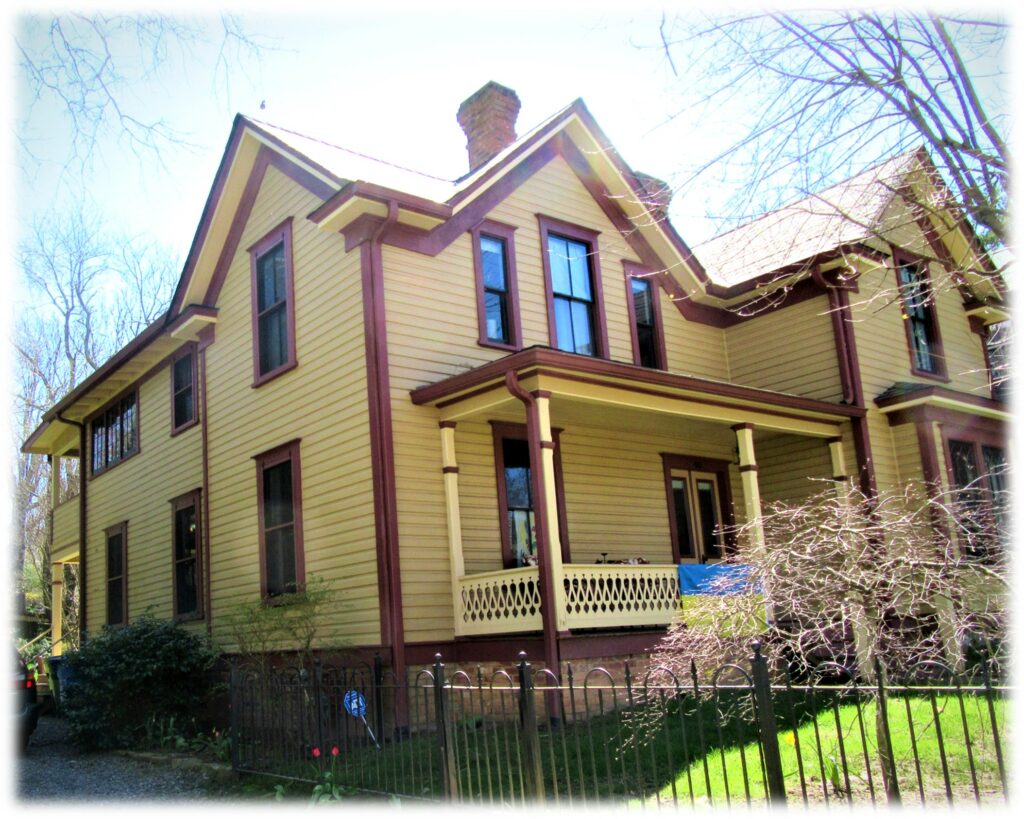By Dale Wayne Slusser
When researching the history of a house, the primary goals, for me, are to try to discover who had the house built, who was the builder and/or architect, and when was the house built. Usually, the answers to these three questions, in most cases, are deduced by a comparison of sources, such as deeds, newspaper articles, and contemporary maps. In the case of the house at 90 Starnes Avenue in downtown Asheville, the answers to those important three questions, were at first very elusive as the comparison of sources seemed conflicting. For instance, although the deeds indicated that the property was owned by eight different owners from 1890 to 1921, only one year, 1900, did the name of the resident match the property owner! An additional series of stumbling blocks, such as the re-addressing of the houses on Starnes Avenue, and the misspelling of owners’ names, all combined to make the answers to these three questions seem almost unattainable- BUT then, despite having done what I thought was a thorough title (deed) search, I suddenly found a deed of trust from 1890 that literally answered all three questions in one document! I was amazed, as most deeds of trust, give little information about the property, except for a reference or boundary description of the property for which the lien is taken out against. Let me take you on my journey of discovery!
As I usually do, I first prepared a “chain of title” for the house at 90 Starnes Avenue, going back to 1888, at which time a parcel of land was sold to M. J. and Amelia Bearden from “J. L. Howell”[1]. This made sense, as I had known from previous research on other nearby properties, that most of the Starnes Avenue properties had been carved out of the former 12–14-acre J. L. Howell property. The Howell property was just east of the W. D. Rankin property. The W. D. Rankin house, now known as the Rankin-Bearden House, still stands at 32 Elizabeth Place.
Also, the Howell property, which clearly shows on an 1886 map of Asheville, fronting on N. Main Street (now Broadway), included the former 18-room mansion of Israel Baird, which was then the home of J. L. Howell. Joseph L. Howell, a wealthy cotton planter from Arkansas, was a native of Buncombe County who had moved to Cotton Plant, Arkansas in 1857, but then in 1869 Howell purchased the former Baird property[2] and began “wintering” in Asheville.
In 1887, Howell decided to sell up and move permanently back to Arkansas. So on September 2, 1887, Howell held an auction where he sold all of his household furniture and furnishings, as well as his horses and carriage.[3] A few days later, on September 6th, 1887, Howell sold a majority of the Howell property (house and land) to the Starnes brothers (T. C, T. F., & George Starnes) and their partner M. E. Roberts.[4] However, the following year, 1888, after already having moved to Arkansas, J. L. Howell sold a small remaining parcel, 200 foot long by 119 foot deep portion of the Howell property, at the southwest corner of Starnes Avenue and Mulberry Street (now Cumberland Avenue), to M. J. Bearden and his wife Amelia Rankin Bearden. Amelia was the daughter of Howell’s neighbor, W. D. Rankin. Although Amelia R. Bearden had inherited numerous lots from the Rankin property, which would be developed along Flint Street and Cumberland Avenue[5], she and her husband M. J. Bearden also invested in other real estate, such as the Howell property on Starnes Avenue.
The chain of title further showed that M. J. Bearden sold his portion of Howell property, just a year later, in August of 1889, to architect/builder Milton Harding.[6] Knowing that Milton Harding, along with providing design and construction services to clients, would often design and build speculative houses for himself, I entertained the assumption that he may have built the house at 90 Starnes Avenue as a spec house. At first it appeared to be a promising assumption as five months later, in January 1890, Harding sold a 60-foot-wide portion of his property (where is now 90 Starnes) to J. K. Sugg.[7] “That’s it!”, I wrongfully assumed- Harding must have built a spec house on part of the parcel and sold it to J. K. Sugg. However, a closer look at both deeds, from Bearden to Harding, and from Harding to Sugg, show that the economics did not support my assumption, as the first deed shows that Harding paid “Seven hundred dollars” for the entire parcel in 1889, but then only charged Sugg “two-hundred and fifty dollars” for his 60-foot-wide plot. Granted it was only half of the parcel that Harding had purchased, yet $250 was not only not half of $700, but it certainly would not have begun to compensate, let alone show a profit for Harding if he had built a house on the parcel before selling it to J. K. Sugg. So, my next assumption, which eventually turned out to be true, was that J. K. Sugg built the house. However, providing support to prove my assumption proved, at first, to be difficult and elusive.
We know that the house at 90 Starnes Avenue was built before 1891 (say in 1890?) as it is shown on the 1891 Bird’s-Eye View Map of Asheville, on the northside of the corner lot sold to J. K. Sugg from Milton Harding in 1890. The house is identifiable by its location and shape, even to the two windows below the center gable on its south façade.
Although the deeds indicated that J. K. Sugg owned the property from 1890 to1896, neither the 1890 nor the 1896 Asheville City Directory listed J. K. Sugg on Starnes Avenue. In fact, Sugg was not even listed in the 1890 directory, and in the 1896 directory he was listed as living at 261 S. Main Street (now Biltmore Avenue). From the house numbering on Starnes Avenue in the street section of the 1896 directory the last house number listed was in the low 30’s, and I suspected that the house now at 90 Starnes, was then addressed as “32 Starnes Avenue”. Further research following the house numbers on Starnes over the course of the years, proved my suspicion to be true, as the house was addressed as 32 Starnes until 1907, when it was renumbered as 90 Starnes Avenue. Of course, this information just added to the conundrum, as it proved that the house was built by 1896 and owned by J. K. Sugg, yet he was listed as living in a rented house on S. Main Street, while his house on Starnes Avenue was being occupied by others. Although the directories appeared to be of little help, the 1896 directory did give a tantalizing clue, as it listed J. K. Sugg as a “carp”, short for carpenter!
The first thing that I could find, besides the deeds, that connected J. K. Sugg with Starnes Avenue was through searching his name in the newspapers.com, under the location of Asheville, NC. One of the earliest references to J. K. Sugg living on Starnes Avenue was from a July 23, 1891 article, simply titled, “Died”. The short obituary read as follows: “At the residence of her husband, Mr. J. K. Suggs on Starnes Avenue, on Saturday evening, Mrs. Atta Suggs in the 36th year of her age. She leaves a husband and five children who deeply mourn their loss. Her remains were buried on Monday. Goldsboro papers please copy.”[8] The obituary presented two major leads, the name of his wife, “Atta Suggs”, and the intriguing phrase: “Goldsboro papers please copy”- obviously there was a connection between the Suggs and Goldsboro. So, off to ancestry.com I went, to learn more of “Atta Suggs” and her connections to Goldsboro.
“Atta Suggs” was more correctly known as Henrietta Eatman Sugg, who was born in 1855, at Wilson, NC to bootmaker (shoemaker), Edwin Eatman and his wife Frances. In 1875, Henrietta Eatman married John K. Sugg at Goldsboro, NC where they were both living at the time. Five years later, in the 1880 census, John & Henrietta Sugg were listed as living on Hall Street in Goldsboro, along with their two children, John E., age 2- and 4-month-old Paul. J. K. Sugg is listed as a carpenter. No wonder that J. K. Sugg requested that his wife’s obituary notice be copied and published in the Goldsboro papers, as it was their hometown, prior to moving to Asheville.
Another Goldsboro-Asheville connection that I discovered was that architect/builder Milton Harding who had sold the lot to J. K. Sugg, had not only (like Sugg) recently moved to Asheville, but Harding had also moved to Asheville from Goldsboro. Milton Harding first moved to Goldsboro, NC from Virginia in 1879 where he immediately began to advertise his services as an architect/builder. “Mr. Milton Harding, of Norfolk, Va., a well-known and experienced architect and builder, has opened an office in our town,” announced the May 8, 1879 edition of the Goldsboro Messenger.[9] In 1884, in addition to providing his services as an architect and builder, Harding established the Goldsboro Planing Mills, providing lumber dressing, millwork and door and sash work.[10] By 1885, Harding was advertising as a full-service contractor: “Plans and Estimates-For-House Building! In all its branches, complete or in detail, including STONE WORK, BRICK WORK, IRON WORK, WOOD WORK, Tinning, Gas Fitting, and Plumbing, Plastering, Painting and Glazing—in fact, for anything required for the erection of either wood, brick, stone, or iron buildings…Milton Harding.”[11] However, that same year, Harding’s wife, Sarah Langley Harding, passed away at the age of 42.[12] A year later, in 1886, Milton Harding sold his Planing mill operation to Nathan O’Berry[13], and by 1889 he had moved his family and business to Asheville.[14] Interestingly, Harding who had moved to Asheville as a widower, married Nancy Estelle Templeton in Asheville in April of 1890, just a few months after selling the lot on Starnes to J. K. Sugg.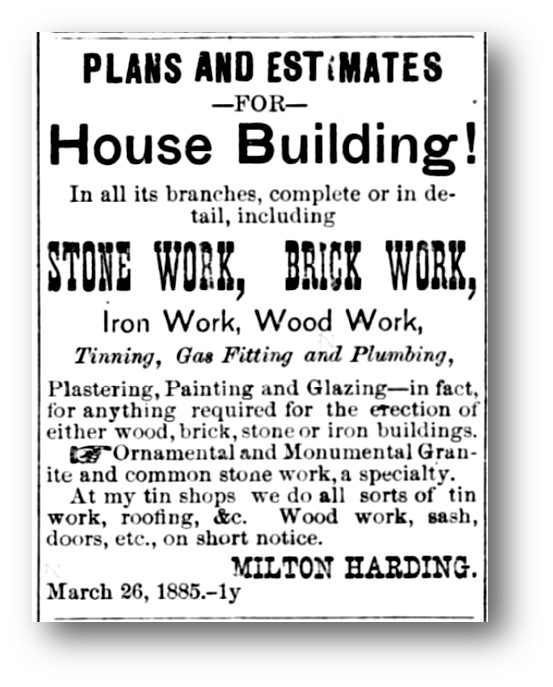 I propose, though I cannot prove it conclusively, that John K. Sugg was a carpenter employed by Milton Harding in Goldsboro and then here in Asheville. Both men, who were in the building trades, seemed to have moved to Asheville about the same time from the same place! According to a “Goldsboro Jottings” published in October of 1889 in the Wilmington Messenger, noted that “Mr. John K. Sugg, who has been living in Asheville for the past two years, is on a visit to his old home and friends here [Goldsboro]”.[15] This “jotting” of 1889 indicates that J. K. Sugg moved to Asheville in late 1887 or early 1888.
I propose, though I cannot prove it conclusively, that John K. Sugg was a carpenter employed by Milton Harding in Goldsboro and then here in Asheville. Both men, who were in the building trades, seemed to have moved to Asheville about the same time from the same place! According to a “Goldsboro Jottings” published in October of 1889 in the Wilmington Messenger, noted that “Mr. John K. Sugg, who has been living in Asheville for the past two years, is on a visit to his old home and friends here [Goldsboro]”.[15] This “jotting” of 1889 indicates that J. K. Sugg moved to Asheville in late 1887 or early 1888.
On November 16, 1891, an article appeared in the Asheville Citizen-Times, with the sad news that J. K. Sugg’s four-year old son Julius had died of pneumonia two days earlier, “at Mr. Suggs home, 32 Starnes Avenue”, and that tragically, “Mr. Suggs has lost three members of his family in the past five months. His wife died in July and his youngest child died about three weeks before.”[16] Although this was tragic news to read, it was conclusive evidence that indeed J. K. Sugg did live and occupy the house at 32 Starnes Avenue (now addressed as 90 Starnes Avenue) between 1890 to 1896. Fortunately, another conclusive article brought happier news in 1892, when it was announced that “J. K. Suggs and Miss Cornelia Eatman were married at the residence of Mr. Suggs, No. 32 Starnes avenue yesterday afternoon at 3 o’clock. Rev. Father White officiated. A number of friends were present.”[17] Just a side note-Cornelia Eatman was the younger sister of J. K. Sugg’s first wife Henrietta Eatman Sugg!
So, we’ve established that J. K. Sugg did live in the house sometime between 1890-1896, (during the years that he owned the property) and the fact that he purchased the lot for $250 but took out various deeds of trust for substantially more was evidence enough that Sugg most likely had the house built. However, I still had two nagging questions about the house at 90 Starnes Avenue: first, who actually constructed the house, and second, if the newspapers indicated that Sugg was living in the house in the early 1890’s, then why is he not listed as the occupant in the 1896 directory? It was in searching for the answer to this second question that I stumbled on the answer to the first question.
I had assumed that the reason that Sugg was not listed as the occupant in the 1896 directory was that, according to the deeds, in September of 1896, Sugg had lost the house in foreclosure due to defaulting on an 1891 deed of trust (third party mortgage). The deed of trust which Sugg defaulted on in 1896 was taken out in 1891, when Sugg, through S. H. Reed, his trustee (agent who received a commission) had borrowed $850 from Fannie A. Smith, a wealthy widow and real estate investor.[18] But it turns out that the 1891 deed of trust was NOT the first source of financing obtained by J. K. Sugg.
It was while delving more closely into Sugg’s financing of the house and trying to unravel his various financings that I found a missing deed of trust from 1890 that revealed some surprising and unexpected information, valuable to the history of the house at 90 Starnes Avenue. Apparently the $850 loan that J. K. Sugg secured from Fannie Smith in 1891 (which he defaulted on in 1896), was to pay off an earlier loan of $890 that Sugg had secured in May of 1890 through R. U. Garrett acting as trustee, from Alexander Garrett (father of R. U. Garrett).[19] Of course, I immediately assumed that the deed of trust to the Garretts was the original mortgage on the Sugg property. BUT then I found an even earlier deed of trust on the property, which Sugg had obtained just one month prior to the Garretts’ deed of trust. In April of 1890, J. K. and Henrietta Sugg had obtained a deed of trust from the Asheville Homestead & Loan Association for $500.[20]
The Asheville Homestead & Loan Association was part of a growing movement of “Building and Loan Associations” in America. Building and Loan Associations were the direct descendants of English building societies, which began in Birmingham, England, in 1781. In America, organizations such as the Oxford Provident Building Association in Pennsylvania (1831) were created to allow subscribers, most of whom were textile workers, to build or purchase houses on a monthly payment plan. A homestead and building associations bill was ratified by the North Carolina General Assembly in 1870.[21] The Asheville Homestead & Loan Association, which had applied for its charter in the September of 1886[22], opened for its first day of business on October 6, 1886.[23] Each stockholder was required to pay one dollar per share each month into the association, whereby the accumulated funds would then be available to its members to be loaned out at 8% interest. The stated object, in the association’s charter was the “accumulation of a fund by the savings or shares of the members, to enable them to purchase or improve for themselves such real estate, as they may deem desirable.”[24] After several months of operation, in April of 1887, the Association reported that: during their first six months their collections were $4,778.35”.[25] Also during those first six months, the Association further reported that, “Assistance has been given in building thirteen houses.”[26] The assistance given was in the form of loans “to help those stockholders, who wish to do so, in building residences for themselves, thereby saving themselves rent, which so soon eats up a mechanic’s income.”[27] The word “mechanic” in the 18th and 19th centuries denoted “manual-worker” or tradesman, such as carpenters, brick masons, plasterers, painters, and jointers (woodworkers). The Asheville Homestead & Loan Association was an early attempt at providing affordable housing for Asheville’s working-class residents-a dilemma that modern-day Asheville is still struggling to address!
Carpenter J. K. Sugg was a shareholder in the Asheville Homestead & Loan Association. In fact, records show that J. K. Sugg was a regular shareholder making monthly contributions of $5.[28] On April 8, 1890, J. K. and Henrietta Sugg obtained a deed of trust from the Asheville Homestead & Loan Association for $500. The deed reads as follows: “Whereas the said John K. Suggs, one of the shareholders in the said corporation made application to the said corporation at a meeting of its Board of Directors held on the third day of April A.D. 1890 for a loan of Five Hundred Dollars ($500) to be paid in the following manner: viz. the sum of Two Hundred Dollars when the frame house now being built by said John K. Suggs, on the land hereinafter described, has progressed so far that the Rafters have been laid– the sum of one hundred and fifty dollars on the 1st day of May A.D. 1890, providing said house is being pushed to a reasonable completion, and the balance of One Hundred and Fifty dollars on the 5th day of June 1890, provided the house is completed by that time…”.[29] The deed further states that John K. Sugg, upon “giving his security” agreed to that he would “faithfully comply” to the following conditions and provisions: “that he will pay to the said corporation monthly, and every month during its continuance on the days appointed by said Corporation for said payment- One Dollar per share on each share held by him, and interest at the rate of eight percent per annum on said loan, payable monthly at the end of each month, that is to say Two Hundred Dollars is to bear interest from the date of these presents, the sum of One Hundred fifty dollars from the first day of May 1890, and the balance of One Hundred and fifty dollars from the 5th day of June 1890…and that he will pay all such fines as may be incurred by default on his part on making the payments on the shares aforesaid, that he will insure the said house while it is being erected against loss by fire in said sum as any good solvent-Insurance Company may insure it during such erection, and after the said house is fully completed that he will then insure it from time to time and at all times hereafter during the continuance of the said Corporation keep it insured to the amount of Three Hundred Dollars…”.[30] Sugg also agreed to pay all yearly assessments and taxes on the house. Interestingly, the Association would run small notices in the Asheville newspapers at the end of each month reminding the shareholders to pay their dues. This unique deed of trust, which contains more information than most deeds, not only gives us a glimpse into the procedural workings of the Asheville Homestead & Loan Association, but it also reveals that J. K. Sugg built the house at 90 Starnes Avenue, and in addition it also gives us a timeline of its construction, between April and June of 1890.
I believe that Sugg completed his house on the timeline set by the provisions of the deed of trust, as a note written on the side of the deed, on page 2, states that: “Mr. S. Hammersley, President and E. I. Holmes, Secretary of the Asheville Homestead & Loan Association do hereby acknowledges satisfaction in full on this mortgage…this July 5th, 1890.”[31] However, just because the deed of trust to Asheville Homestead & Loan Association was “satisfied” (paid off) doesn’t mean that the house was paid off, and in fact, I believe that’s why in May of 1890 Sugg borrowed the $850 from the Garretts (mentioned above), to not only pay of the $500 loan from the Asheville Homestead & Loan Association, but also to cover the purchase of the lot as well as perhaps to cover any costs overruns on the house. Then as previously mentioned, Sugg borrowed $890 from Fannie Smith in 1891, no doubt to pay off the $850 Garrett loan (and cover the interest on the loan). It was on the Fannie Smith loan that J. K. Sugg defaulted and in 1896 the house was foreclosed with Fannie Smith re-purchasing the property at the Courthouse sale.
Speaking of the 1896 foreclosure, that reminds me that I also solved the mystery of why J. K. Sugg was listed in the 1896 Asheville City Directory as living on S. Main Street instead of at his house on Starnes Avenue? Simply because he had lost the house to foreclosure. But an interesting twist to the story is that a “J. L. Baker” is listed as living at 32 Starnes Avenue, in Sugg’s house in the 1896 directory. It turns out that J. L. Baker was a house painter who also happened to be the brother-in-law of J. K. Sugg, married to Suggs sister, Nancy Elizabeth Sugg Baker! Also living in the house with the Bakers was J. K. & Nancy’s mother, Harriett Sugg. I suspect that Sugg rented the house out to his son-in-law, after the first few years, to generate income to help pay the mortgage, and/or to contribute to the upkeep of his mother, by providing a house. The Baker’s continued to live in the house until 1898, even after it was bought by Fannie Smith in 1896. The Baker’s moved in late 1898 or early 1899, to 76 Cherry Street (almost in their backyard) where in 1899, Harriett Sugg passed away.
Fannie Smith sold the house to Archibald Nichols in 1900, who lived there only a few years, selling it in 1904 to investors, W. H. & Marietta Pearson. The house went through a few additional investor owners until 1919, when the house was purchased by Mrs. C. N. Maxwell, who was the first owner/occupier since 1904. But then Maxwell sold the house in 1921 to Miss Florence Radford and her mother Mrs. Beatrice Radford. The house remained in the family Radford family until the death of Florence Radford Porter (she had married John Bones Porter) in 1981. Florence willed the house to her caregiver-companion, widow Gertrude Lytle Redmon, who had moved in with Florence in 1954.[32] Gertrude Redmon lived in the house until her death in 2001 at the age of 91.[33] Redmon’s heirs sold the house in 2002 to Keith & Debra Harwood. The Harwoods restored the home before selling it to its current owner, William Eakins, in 2002. Eakins lovingly maintains the home and has furnished it with period antiques.
J.K. Sugg built a finely detailed and crafted home for himself and his family in 1890, but sadly, less than six years later he had to move to rented quarters and would live in rented houses until his death in 1920 at the age of 69. But the little house that J. K. Sugg built at 90 Starnes Avenue, not only has continued to provide a tasteful and attractive home for many families over the past 130 years, but it contributes to the charm and desirability of Asheville’s historic Montford neighborhood.
Photo & Image Credits: (Note: All cropping and captions by author)
Color photos of the house- Taken by the author.
Closeup of Howell Property on 1886 Map- MAP200- Buncombe County Special Collections, Pack Memorial Library, Asheville, NC.
Closeup from 1891 Bird’s-Eye View of Asheville- Ruger & Stoner, and Burleigh Litho. bird’s-eye view of the city of Asheville, North Carolina. [Madison, Wis, 1891] Map. https://www.loc.gov/item/75694894/
Milton Harding Advertisement- Goldsboro Messenger, Goldsboro, NC, April 23, 1885, page 8.- newspapers.com
Asheville Homestead & loan Association Article- Asheville Citizen-Times, April 8, 1887, page 1. . -newspapers.com
Vignette of Deed of Trust from J. K. Sugg to Asheville Homestead & Loan Association- 04/08/1890 (rec’d-04/09/1890) John K. & Henrietta E. Sugg to Asheville Homestead & Loan Association [D/T] CORRECTED 6/24/2020 Db. 19/483. -Buncombe County Register of Deeds.
[1] 08/04/1888 (rec’d-02/26/1889) J. L. & Fannie Howell to M. J. & Amelia Bearden MULBERRY STREET & STARNES AVENUE Db. 65/10.-Buncombe County Register of Deeds.
[2] 03/1875 (rec’d-09/28/1880) Arthur & Fannie Davis to Joseph L. Howell TURNPIKE RD 12 ACRES Db. 40/520.-Buncombe County Register of Deeds. However, although the deed was not signed until 1875, and not recorded until 1880, an article in the August 20, 1869 edition of the Asheville News(page2), announced that “Mr. Davis, of Cartersville, was with us a few days, and sold his beautiful residence here to Mr. J. L. Howell of Arkansas, whom he found here with his family.”
[3] “AT AUCTION”, Asheville Citizen-Times, September 2, 1887, page 2. .- newspapers.com
[4] 09/06/1887 (rec’d-09/10/1887 J. L. & Fannie Howell to T. C. Starnes; T. F. Starnes; George Starnes; & M. E. Roberts MAIN AND CHERRY STREETS Db. 60/216.- Buncombe County Register of Deeds.
[5] See the “Ann E. Rankin & Maud Lambert” Plat, 07/06/1904 -PLAT CUMBERLAND AVENUE & CHESTNUT STREET, Db. 8/57.-Buncombe County Register of Deeds. Notice on the plat the various lot owners’ initials, as all are Rankin family members.
[6] 08/10/1889 (rec’d-01/13/1890) M. J. & Amelia R. Bearden to Milton Harding MULBERRY STREET Db. 68/575. “…for the sum of seven hundred dollars…”- Buncombe County Register of Deeds.
[7] 01/13/1890 Milton Harding to John K Sugg STARNES AVENUE Db. 68/578. “sum of two hundred and fifty dollars…a certain
piece, parcel or lot of land….”.- Buncombe County Register of Deeds.
[8] “Died”, The Asheville Democrat, July 23, 1891, page 8.-newspapers.com
[9] Goldsboro Messenger, Goldsboro, NC, May 8, 1879, page 3.- newspapers.com
[10] “Goldsboro Planing Mills”, Goldsboro Messenger, Goldsboro, NC, May 29, 1884, page 5.- newspapers.com
[11] Goldsboro Messenger, Goldsboro, NC, April 23, 1885, page 8.- newspapers.com
[12] Goldsboro Messenger, Goldsboro, NC, May 11, 1885, page 4.- newspapers.com
[13] Goldsboro Messenger, Goldsboro, NC, April 1, 1886, page 4.- newspapers.com
[14] Asheville Citizen-Times, March 31, 1889, page 1. .- newspapers.com
[15] “Goldsboro Jottings”, The Wilmington Messenger, Wilmington, NC, October 17, 1889, page 2.
[16] Asheville Citizen-Times, November 16, 1891, page 4. .- newspapers.com
[17] Asheville Citizen-Times, January 11, 1892, page 4. .- newspapers.com
[18] 09/15/1891 (rec’d-09/29/1891) John K Sugg to S H Reed (party of the second part) ; Fannie A Smith (party of third part) [D/T] Db. 27/5- Buncombe County Register of Deeds.
[19] 05/28/1890 (rec’d-06/14/1890) John K Sugg to Robert U. Garrett (party of the second part) & Alexander Garrett (party of the third part) D/T Db. 20/573. – Buncombe County Register of Deeds.
[20] 04/08/1890 (rec’d-04/09/1890) John K. & Henrietta E. Sugg to Asheville Homestead & Loan Association [D/T] CORRECTED 6/24/2020 Db. 19/483. -Buncombe County Register of Deeds.
[21] “Building and Loan Associations” by Clarence E. Horton Jr., 2006- This article is from the Encyclopedia of North Carolina edited by William S. Powell. Copyright © 2006 by the University of North Carolina Press- https://www.ncpedia.org/building-and-loan-associations
[22] Asheville Citizen-Times, September 23, 1886, page 4. .- newspapers.com
[23] Asheville Citizen-Times, April 8, 1887, page 1. .- newspapers.com
[24] Asheville Citizen-Times, September 23, 1886, page 4. .- newspapers.com
[25] Asheville Citizen-Times, April 8, 1887, page 1. .- newspapers.com
[26] Ibid.
[27] Ibid.
[28] Asheville Homestead & Loan Association Book– PC.AB.495- State Archives of North Carolina, NC Department of Natural and Cultural Resources, Raleigh, NC 27601.
[29] 04/08/1890 (rec’d-04/09/1890) John K. & Henrietta E. Sugg to Asheville Homestead & Loan Association [D/T] CORRECTED 6/24/2020 Db. 19/483. -Buncombe County Register of Deeds.
[30] Ibid.
[31] Ibid.
[32] 1954 is the first year that Gertrude L. Redmon is listed as living at 90 Starnes Avenue.
[33] “Gertrude Lytle Redmon”, Asheville-Citizen Times, November 17, 2001, page 16.- newspapers.com

